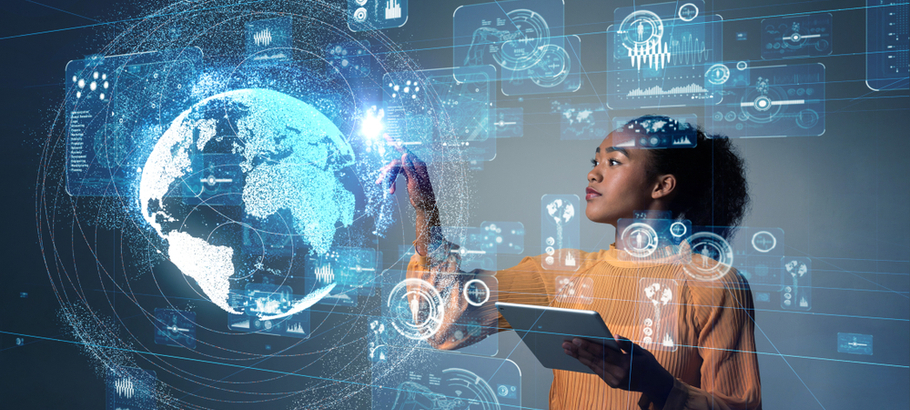Have you ever wondered how to explore the vast space? Which type of techniques scientists apply to explore the universe? This is the most common probing questions run in the majority of human being’s brain. The solution to these questions is Artificial Intelligence. This blog covers the information regarding the role of AI to explore the Universe along with applications.
Trending technologies have led to a progressive interest in the AI system in the aerospace field. Enhanced research systems of space tools enclosed with machine learning and AI can help to explore the universe with ease.
Artificial intelligence
Artificial intelligence is a facsimile of human intelligence in a system capable of learning from experience. It allows the machine to perform human-associated tasks. Thus, the aerospace community utilizes these systems to develop intelligent robot agents.
Artificial intelligence in space
- The artificial program discovers photos of the space more quickly than a human being.
- Scientist implements Artificial intelligence techniques to understand and explore the universe. Because it is a very tough task for a human being thus, researchers strive to discover new artificial systems to process vast information. These systems could assist them in discovering difficult mysteries related to planets.
- NASA Scientists rely on AI algorithms to figure out challenges in space science. Thus they are partnering with big companies like IBM, Google and more.
- AI is used to manage huge data in space
- Smart models comprised of machine learning and AI concepts to manage and solve the planet to data transmission problems.
- AI assist figure out how to synthesize a complex molecule to cure for a particular disease
Applications of AI in Universe exploration
Machine learning:
The AI-based system is made up of machine learning concepts to learn from existing data to perform predictions and object categorization more quickly in comparison to humans.
AI Data-driven approaches:
These approaches rely on unsupervised learning algorithms implemented in safety-critical applications in space to make corrective actions.
- Used to discover exhaustive datasets to perform fault representation
- Malfunctions identification
- Time-series Analysis
Model-based approaches:
This type of algorithm is used for enhanced based awareness including onboard planning, nominal state transition prediction, spacecraft commands monitoring.
Spacecraft System design:
Scientists are continuously using Artificial based innovative approaches to overcome the rapidly growing complexity. The approaches permit a large number of design assessment of subsystems. This includes telemetry tracking and command, thermal structures and mechanisms, data handling, and attitude determination.
Feature detection:
AI is used in the geographical analysis of the planet. This includes sending back photographs back to earth. This mechanism is very beneficial to classify photos and analyze their features. This feature is enabled by on-ground rovers to constitute data. Humans are not too perfect to perform classification. Thus, scientists implement AI dependent classifications to execute on memory-constrained machines.
Satellite Navigation:
AI-based neural network encouraged for satellite navigation. This approach was determined as an efficient parameter.
Payload optimization:
The terms like payload optimization and trajectory are associated with the Mars rover mission. This includes AI algorithms. This permits the camera’s autonomous targeting management, vehicle control, etc.
Exoplanet Kepler-90i:
NASA has identified Exoplanet Kepler-90i with the help of Machine learning Algorithms. The researched have trained neural network classifier system to perform learning. Which in turn results in exoplanets discovery? Researchers discovered 8 planets.
Future of AI in space:
Scientists are planning to discover AI-based robots for future space exploration. AI has great potential to investigate more from the Universe. Thus, researchers are intending to add such an algorithm in NASA’s Mars Science laboratory to research in space. This includes service robots to manage tools, obstacles navigation, and flying object discovery. The AI-powered robot will carry out the entire household criteria’s in space. With the increase in technology, scientists are trying to implement advanced and deep learning concepts to develop more intelligent robots.
Example:
In Chandrayaan-2 which is the second mission of India, AI will play a compelling aspect in the mission success.
AI: Perfect tool to Explore Universe
Artificial intelligence subsidizes astronauts to onboard the international solar system. There are numerous intelligent data transmission tools available that eliminate human scheduling errors. These AI technology criteria’s will be the perfect tool to explore the space.
Conclusion
Autonomous models with AI-dependent programs will play a massive role to discover more insights about the space atmosphere. Moreover, it assists astronaut’s community to find the right directions and space flights. And at last, we can conclude that AI can explore the universe in a much better way than humans.




